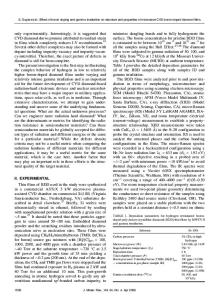Neutron irradiation and annealing of 10 B doped chemical vapor deposited diamond films
- PDF / 526,399 Bytes
- 8 Pages / 576 x 792 pts Page_size
- 55 Downloads / 388 Views
Galina Popovici Nuclear Engineering Department, University of Missouri, Columbia, Missouri 65211, and Rockford Diamond Technology, Professional Arts Bldg., 501 S. Sixth Street, Champaign, Illinois 61820-55789
J. Farmer University of Missouri Research Reactor, Columbia, Missouri 6521 1
T. Sung and M . A . Prelas Nuclear Engineering Department, University of Missouri, Columbia, Missouri 65211
J. Chamberlain and H. White Physics Department, University of Missouri, Columbia, Missouri 6521 1 (Received 17 December 1994; accepted 15 June 1995) loB doped diamond films grown by hot filament chemical vapor deposition were neutron irradiated at moderately high fluence levels. The as-irradiated and annealed samples, along with an unirradiated sample, were analyzed using Raman spectroscopy and x-ray diffraction. It was found that a non-diamond amorphous phase was formed on irradiation. This phase transformed back to diamond on annealing. No graphite formation was observed. A comparison with nanodiamond powder was made. A similarity between irradiated diamond films and nanocrystalline diamond powder is discussed.
I. INTRODUCTION
Diamond films produced by chemical vapor deposition (CVD) have a wide array of potential applications. With the advent of new technologies in this area, diamond-based electronics is becoming a reality. The large band gap and the resistance to chemical and radiation damage permit diamond applications not possible with the silicon technology. These include high temperature electronics, electronics for space usage, radiation detectors, and instrumentation for nuclear reactors. Interest in the study of irradiation and annealing of boron-doped diamond films is twofold. First, boron is commonly used as an acceptor dopant in diamond electronics. Natural boron contains 80.1% ''B and 19.9% log. 'OB has a large neutron capture cross section with the reaction loB ( n , a ) 7Li. The energy of the reaction is rather high (2.7 MeV), so radiation defects will be created. Therefore, a study of neutronirradiated, boron-doped films is of interest for electronic applications in high neutron radiation environments. Second, Li-doping can be achieved by the reaction loB ( n ,a ) 7Li with isotopically enriched boron.' Interstitial lithium is predicted to be a shallow donor.2 This could be a useful method of n-type doping if the feasibility of removing radiation defects is demonstrated. It is known that on annealing, the damaged regions can J. Mater. Res., Vol. 10, No. 10, Oct 1995 http://journals.cambridge.org
Downloaded: 14 Mar 2015
reconstitute diamond or graphiti~e,~ depending on the irradiation dose. The graphitization happens at high irradiation doses when a large amount of sp3 bonds are broken, and the lattice becomes amorphous. There is a wealth of literature on irradiation of natural and synthetic diamonds by high-energy particle^.^-^ However, neutron irradiation studies on boron-doped CVD diamond films have not yet been reported. In this paper the influence of neutron radiation on the quality of 'OB doped diamo
Data Loading...











